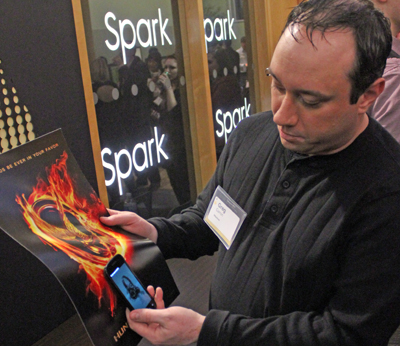Canadian Magazine Industry News
1 April 2012, TORONTO
NFC technology enhancing magazine ads
Packaging that can tell your microwave how long to cook food?
That's a possibility of a rising technology called near field communication (NFC), those on hand for the Ryerson University Graphics Communication Management Colloquium 2012 [Spark] heard on Thursday night.
The technology allows smartphones to communicate with chips [or "tags"] embedded in printed material, including magazine pages, posters and packaging of all kinds, to offer more information for the consumer with a tap of the phone near the tag.
That being said, at least one magazine, Wired, is using the technology to enhance ads as highlighted by this article in NFC World.
Owen Duckman, president of Labelad which specializes in pressure-sensitive labels and flexible packaging, was on hand to talk about the new technology. He predicts NFC will trump quick response [QR] codes, which take a smartphone user to a website by scanning a code on printed material. NFC will allow "endless possibilities", including the ability to 'like' an item via Facebook just by tapping it, he said.
The technology could also mean "talking packaging" for the visually impaired via a smartphone, and the ability to program cooking time just by touching packaging to a microwave. "It's not so far-fetched, it's a matter of creativity and cost," said Duckman.
And what is the cost? About 30 to 50 cents per tag, the audience heard. The tags are vulnerable to static, and not all smartphones are compatible with them yet, although it's becoming a more common feature, explained Duckman.
There are also currently privacy concerns related to NFC technology in terms of what information is being collected from users, and the tags can potentially interfere with recycling, the panelists offered.
The Spark presentations were followed by NFC product demos and dinner at Ryerson's Heidelberg Centre. The colloquium is an annual event hosted by third year students of Ryerson's Graphic Communications Management program.
This content originally appeared on Masthead sister site PrintCAN.com.
That's a possibility of a rising technology called near field communication (NFC), those on hand for the Ryerson University Graphics Communication Management Colloquium 2012 [Spark] heard on Thursday night.
The technology allows smartphones to communicate with chips [or "tags"] embedded in printed material, including magazine pages, posters and packaging of all kinds, to offer more information for the consumer with a tap of the phone near the tag.
 |
|
Greg Carron of BNotions, which develops mobile apps, demonstrates an NFC tag embedded movie poster
|
That being said, at least one magazine, Wired, is using the technology to enhance ads as highlighted by this article in NFC World.
Owen Duckman, president of Labelad which specializes in pressure-sensitive labels and flexible packaging, was on hand to talk about the new technology. He predicts NFC will trump quick response [QR] codes, which take a smartphone user to a website by scanning a code on printed material. NFC will allow "endless possibilities", including the ability to 'like' an item via Facebook just by tapping it, he said.
The technology could also mean "talking packaging" for the visually impaired via a smartphone, and the ability to program cooking time just by touching packaging to a microwave. "It's not so far-fetched, it's a matter of creativity and cost," said Duckman.
And what is the cost? About 30 to 50 cents per tag, the audience heard. The tags are vulnerable to static, and not all smartphones are compatible with them yet, although it's becoming a more common feature, explained Duckman.
There are also currently privacy concerns related to NFC technology in terms of what information is being collected from users, and the tags can potentially interfere with recycling, the panelists offered.
The Spark presentations were followed by NFC product demos and dinner at Ryerson's Heidelberg Centre. The colloquium is an annual event hosted by third year students of Ryerson's Graphic Communications Management program.
This content originally appeared on Masthead sister site PrintCAN.com.
— Jeff Hayward
Comments (2) Post a Comment
Most Recent News Comment
 |
|
| Jaded says: | |
Wow, Torstar really seems to be on a mission to bankrupt one magazine after another.... |
|
Most Recent Blog Comment
 |
|
| Lorene Shyba says: | |
Full of terrific information, Thanks!... |
|
Most Read Stories
Special Reports
Masthead Web Edition Archives
- November 2025
- October 2025
- September 2025
- August 2025
- July 2025
- June 2025
- May 2025
- April 2025
- March 2025
- February 2025
- January 2025




